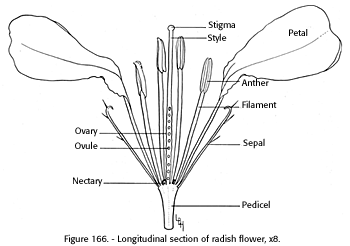RADISH
Raphanus sativus L., family CruciferaeRadish is grown almost entirely for the use of its succulent root as a green salad vegetable. It is a popular home garden vegetable because it is ready to harvest 3 to 6 weeks after planting. Radishes grow best in rather cool weather - fall and spring of the Northern States and late fall, winter, and early spring of the warmer areas.
An estimated 1.9 million pounds of radish seed was produced on 1,347 acres in 1971. Production was largely in California, although some was produced in Idaho, Montana, and Wyoming. Seed yields per acre range from 500 to 1,200 pounds. In most years, more acres of radish are grown for seed and more seed is produced in the United States than of any other cruciferous vegetable crop (Hawthorn and Pollard 1954*).
Plant:
The radish grown in the United States is primarily an annual, although biennial types occur. The plant first produces a relatively small rosette of leaves, compared to the cole crops, mustard and rape, the leaves being only 6 to 18 inches long, and a succulent fleshy taproot l/2 to 2 inches thick and 1 to 12 inches long, depending upon the type and cultivar. After the root growth is completed, the flowering stem elongates to a height of 2 to 3 feet. The root is harvested as soon as possible after it reaches market size. The longer it remains in the soil afterwards, the less tasty it becomes.
There is no problem of shattering in the harvest of radish seed, as the pods do not dehisce. The seeds are usually harvested with standard or all-purpose combines (Hawthorn and Pollard 1954*).
Inflorescence:
The white to lilac cruciferous flowers are smaller and less showy than those of mustard or rape. Each day of flowering three florets usually appear on the tip of each branch of the panicle (fig. 166). Each flower is capable of producing a pod 1 to 3 inches long and containing one to six seeds (Bailey 1949*) or possibly up to 12 seeds. (See "Cole Crops" for details of the cruciferous flower. )
Kremer (1945) stated that the flower opens during the morning with the corolla remaining fresh throughout the day or into the second day. He indicated that pollen receptivity of the flower was limited to a few hours of the day. Radish is the source of some nectar and pollen, but Kremer (1945) stated that honey bee flight volume in radish fields was less than half that in clover fields, with little activity in the afternoons.
[gfx] FIGURE 166. - Longitudinal section of radish flower, x 8.

Pollination Requirements:
The pollination of radish was studied by Crane and Mather (1943), Kremer (1945), and Radchenko (1966). The cross-pollination of radish was the main object of the study by Crane and Mather (1943) who found that the 'Icicle' and 'Scarlet Globe' cvs. were self-incompatible and that crossing decreased from 30 to 40 percent at 9 inches, to 1 percent at 15 feet, and 0.1 percent at 240 feet. Radchenko (1966) stated that pollination was primarily by honey bees (77 to 94 percent of the total) and that bee pollination increased the seed crop by 22 percent and enhanced seed quality. All seemed to agree with Jones and Rosa (1928*) that the radish is almost entirely insect-pollinated.
Pollinators:
Honey bees are the most important agents in the pollination of the radish. The studies by Kremer (1945) indicate that the seed yield is largely influenced by the number of honey bees visiting the radish flowers. Radchenko (1966) also reported that honey bees were the main pollinators of radish flowers, accounting for 77 to 99 percent of the total, increasing the crop by 22 percent, and enhancing the seed quality. Crane and Mather (1943) also accredited honey bees with effectively setting the seed crop, noting that the seed set was especially heavy near 25 colonies of honey bees.
Pollination Recommendations and Practices:
Kremer (1945) indicated the need for honey bees, only stating that the nearer the hives to the plants the better. He cautioned that when colonies are not nearby, or when major honey-producing plants flower between the apiary and the radish field, many of the radish flowers are not visited by bees, pollination does not occur, and seed yields are reduced. He suggested renting colonies of honey bees if none are close by at radish flowering time.
Although the number of colonies or units of bees per unit of blossoms has not been indicated, the relatively short length of time the flower is receptive and its relative unattractiveness would indicate that a higher population of bees might be necessary than the one or two colonies per acre mentioned for rape pollination.
LITERATURE CITED:
CRANE, M. B., and MATHER, K.
1943. THE NATURAL CROSS-POLLINATION OF CROP PLANTS WITH PARTICULAR REFERENCE TO RADISH. Ann. Appl. Biol. 30: 301-308.KREMER, J. C.
1945. INFLUENCE OF HONEY BEE HABITS ON RADISH SEED YIELD. Mich. Agr. Expt. Sta. Quart. Bul. 27: 413-420.RADCHENKO, T. H.
1966. [ROLE OF HONEY BEES AS POLLINATORS IN INCREASING THE SEED CROP FROM CABBAGE AND RADISH.] Bdzhil'nitstvo 2: 72-74. [In Ukrainian.] AA-390/69.
